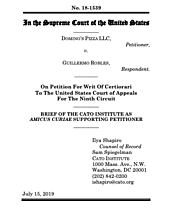While no court has ruled that virtual platforms are entirely beyond Title III’s ambit, some have limited it to the websites of brick-and-mortar establishments like restaurants and department stores, provided those websites share a commercial “nexus” to discrete physical locations. Others would extend it to website-only businesses (think Netflix). In short, there is no central Title III definition to guide courts on how to fit websites and apps into an analytical framework devised in the analog age. And the Department of Justice (DOJ) has only muddied the waters, offering prevaricating, non-binding guidance, in lieu of long-promised rules and regulations, the latest proposals for which were quietly withdrawn in 2017.
Congress intended the ADA to reshape the cultural and architectural landscape of American society to make it more welcoming to disabled people by compelling businesses to construct ramps, include braille signage, and provide countless other aids to ensure that the disabled have equal access to goods and services. But the ADA doesn’t define “access” with precision. It certainly doesn’t advise businesses on what they must do to avoid Title III liability. It does, however, list the types of “places of public accommodation” to which it applies, places that are alike only in their physicality (e.g., a concert hall and a barber shop).
That brings us to Guillermo Robles, a blind man who sued Domino’s Pizza, alleging that the company’s website doesn’t allow him to order pizza online. The federal district court ruled that, while Title III did apply to websites and apps, the absence of a formal rule meant businesses didn’t have sufficient notice of how to comply. The U.S. Court of Appeals for the Ninth Circuit reversed, holding that existing DOJ guidance is sufficient. Domino’s has asked the Supreme Court to review that ruling and Cato has filed a brief supporting that request.
Courts that define website-only businesses as “places” of public accommodation in themselves have gone a bridge too far. So too have those courts that define the “nexus” between a website and a physical location so broadly as to require every page of a commercial website—even those pages that don’t involve access to a physical location—to have a Title III-compliant interface. And since DOJ remains largely in an advisory role, courts have invented their own compliance criteria, or adopted as binding certain guidelines offered by international standard-setters—even though many businesses have warned of the significant expense these approaches entail.
The compliance costs of this regulatory morass are too great for the Supreme Court to ignore. The confusion emanating from a rudderless bench and a reticent DOJ has opened the floodgates of litigation, driven largely by a plaintiffs’ bar more interested in attorneys’ fees than improving their clients’ lives. By one count, the number of Title III lawsuits rose from 7,663 in 2017 to 10,163 in 2018—a more than 30% increase. Without the Court’s intervention, the costs of this “regulation by litigation” will continue to rise, like so much dough in a wood-fired pizza oven. Although the facts of each case vary, the recent onslaught of claims target businesses both big and small. Today, its Domino’s Pizza or Netflix. Tomorrow, it’s a local contractor with far-more limited resources. The ADA was never meant to be a business-killer, so courts shouldn’t make it into one unless Congress so specifies in no uncertain terms.



